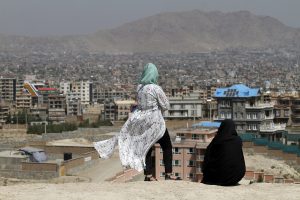[ad_1]

Afghan women look at the skyline of Kabul, Afghanistan, Monday, September 14, 2020.
Credit: AP Photo/Rahmat Gul
From 2002 to 2020, the U.S. government disbursed at least $787 million for programs to support Afghan women and girls. What progress did those funds buy and how easily could it all be lost?
Speaking at a Brookings Institution event last week to unveil his office’s latest lessons learned report, Special Inspector General for Afghanistan Reconstruction (SIGAR) John F. Sopko put the report’s release in context: “We release it as the new administration faces a critical issue – how the United States can continue to support Afghan women and girls at a time of great uncertainty about their nation’s future.”
The 165-page report (plus annexes) is a comprehensive tour through nearly two decades of reconstruction work focused on women and girls in Afghanistan. The report found some success, but plenty of failure, too; much of it rooted in a lack of understanding (and subsequent lack of considerations of) local cultural contexts in the design and implementation of programs.
Since 2001, SIGAR notes significant progress in a variety of fields, from health and education metrics to political and economic participation. But the gains have been “tempered,” the report noted, by sociocultural norms and insecurity. In an ironic twist, while high-level political focus on gender issues in Afghanistan meant greater congressional and executive branch support, and significant funding, the “political focus may also have reduced the scrutiny accorded to the design of some gender programs.”
And program design matters.
Promoting women’s rights in Afghanistan has been a goal of U.S. reconstruction efforts since 2002, but SIGAR found that some programs achieved better success than others. “Some programs were designed based on assumptions that proved to be ill suited to the Afghan context,” Sopko said in his remarks.
The “Afghan context” is a society as complex as societies the world over, burdened by history and a patriarchal culture. As Sopko highlighted in his remarks, the experiences of Afghan women are too often simplified in international eyes: either mini-skirt clad students of 1970s Kabul or women in dusty villages hidden under burqas in the 1990s. “As we note in the report, such one-dimensional narratives can undermine even the most well-intentioned efforts to ensure women and girls are afforded basic human rights,” Sopko said.
As in other societies, there exist in Afghanistan restrictive social and cultural norms relating to the behavior of women and girls. In Afghanistan, the report notes, these “predate and transcend the Taliban.” This is an important point to underscore: If the Taliban were to vanish entirely tomorrow, the difficulties faced by women in Afghanistan would remain. That said, if the Taliban were to return fully to power in Afghanistan, the gains made by Afghan women could too easily vanish.
Another of the report’s key findings notes that historically, “Afghan leaders’ efforts to advance women’s rights have spurred backlash, especially in rural areas, and have been most successful when based on a broad social consensus.” Walking the tightrope of progress without engendering a backlash might be an impossible task, but it’s a worthy endeavor.
In offering lessons, SIGAR highlights the value of U.S. and international pressure in advancing women’s rights but also the necessity of U.S. officials developing and employing a deeper understanding of Afghanistan’s cultural contexts. The lessons also note that educating Afghan men and boys about gender equality is critical. This is as true in the mission to advance women’s rights in Afghanistan as it is in the West.
In laying out the report’s findings, a final point was worth highlighting: “The effort to promote women’s rights may be hampered by a growing narrative in Afghanistan that the country can either have women’s rights at the cost of peace, or peace at the cost of women’s rights.”
This is a dangerous narrative that feeds into a broader zero-sum view of rights in which women’s gains come at the expense of men.
“I do not believe gender equality is a zero-sum game,” Sopko said in his remarks.
In the Afghan context, the emerging narrative that defending “women’s rights” might derail the peace process is a troubling and false set-up. Such as narrative presupposes that sacrificing women’s rights could even buy peace, as if such a thing could be sacrificed like a lamb on the altar.
After more than a month hiatus, negotiators from the Taliban and the Afghan government met again on February 22. The two sides are still working on an agenda for talks, with the Afghan government prioritizing a ceasefire and the Taliban dancing around ideas of political arrangements but mostly waiting for the Biden administration to finish its review of the Trump-era Doha agreement.
Women’s rights are certainly a facet in the negotiations but they are not the only point of tension between the two sides. SIGAR stresses in its conclusion the importance of the U.S. advocating a greater role for women in the negotiations. Amid the extant political uncertainty, the Afghan government’s continued dependence on the U.S. gives Washington a degree of leverage it can, and should, use to “remind Afghan powerbrokers that the world is watching, and lend support to Afghan leaders and advocates who share U.S. goals.”
[ad_2]
Source link